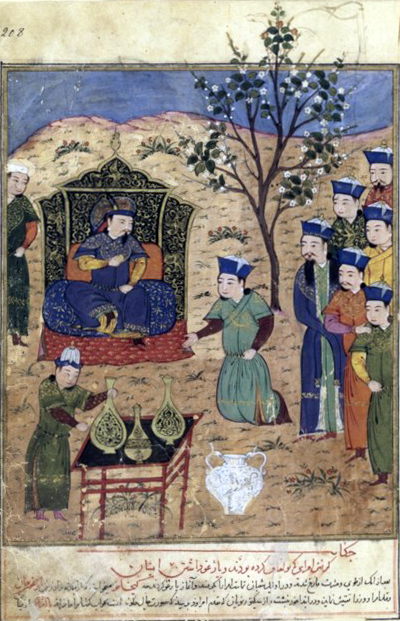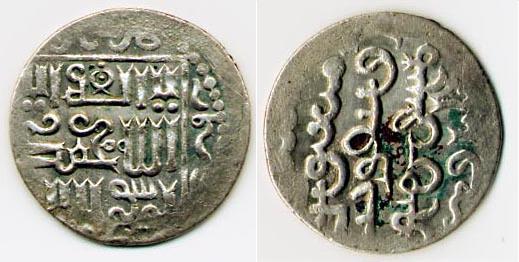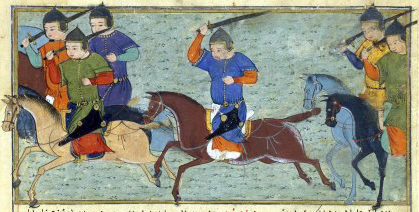|
Gaykhatu
Gaykhatu (Mongolian script:; ) was the fifth Ilkhanate ruler in Iran. He reigned from 1291 to 1295. His Buddhist baghshi gave him the Tibetan name Rinchindorj () which appeared on his paper money. Early life He was born to Abaqa and Nukdan Khatun, a Tatar lady in c.1259. He was living in Jazira during Tekuder's reign and had to flee to Arghun in Khorasan after Qonqurtai's execution in 1284. He was given as hostage to Tekuder by Arghun as a condition of truce in June 1284 and put in orda of Todai Khatun, his step-mother. After Arghun's enthronement, he was confirmed as governor of Anatolia together with his uncle Hulachu. Rule in Anatolia He was stationed in Erzinjan and learnt to speak Persian and to some degree Turkish during his stay in Anatolia. Gaykhatu ruled Anatolia solely after recall of Hulachu to Iran in 1286. It was then he was married to Padishah Khatun, a princess of Qutlugh-Khanids. He aided Masud II on his campaigns against Turkmen principalities, most importa ... [...More Info...] [...Related Items...] OR: [Wikipedia] [Google] [Baidu] |
Baydu
Baydu (Mongolian script:; ) (died 1295) was the sixth ruler of the Mongol empire's Ilkhanate division in Iran. He was the son of Taraqai, who was in turn the fifth son of Hulagu Khan.Stevens, John. ''The history of Persia. Containing, the lives and memorable actions of its kings from the first erecting of that monarchy to this time; an exact Description of all its Dominions; a curious Account of India, China, Tartary, Kermon, Arabia, Nixabur, and the Islands of Ceylon and Timor; as also of all Cities occasionally mention'd, as Schiras, Samarkand, Bokara, &c. Manners and Customs of those People, Persian Worshippers of Fire; Plants, Beasts, Product, and Trade. With many instructive and pleasant digressions, being remarkable Stories or Passages, occasionally occurring, as Strange Burials; Burning of the Dead; Liquors of several Countries; Hunting; Fishing; Practice of Physick; famous Physicians in the East; Actions of Tamerlan, &c. To which is added, an abridgment of the lives of the ki ... [...More Info...] [...Related Items...] OR: [Wikipedia] [Google] [Baidu] |
Arghun
Arghun Khan (Mongolian Cyrillic: ''Аргун хан''; Traditional Mongolian: ; c. 1258 – 10 March 1291) was the fourth ruler of the Mongol empire's Ilkhanate, from 1284 to 1291. He was the son of Abaqa Khan, and like his father, was a devout Buddhist (although pro-Christian). He was known for sending several embassies to Europe in an unsuccessful attempt to form a Franco–Mongol alliance against the Muslims in the Holy Land. It was also Arghun who requested a new bride from his great-uncle Kublai Khan. The mission to escort the young Kököchin across Asia to Arghun was reportedly taken by Marco Polo. Arghun died before Kököchin arrived, so she instead married Arghun's son, Ghazan. Early life Arghun was born to Abaqa Khan and his Öngüd, possibly Christian concubine Qaitmish egechi in 8 March 1259 (although Rashid al-Din states it was in 1262, which is unlikely) near Baylaqan. He grew up in Khorasan under care of Sartaq Noyan (from Jalair tribe) who was his militar ... [...More Info...] [...Related Items...] OR: [Wikipedia] [Google] [Baidu] |
Ilkhanate
The Ilkhanate, also spelled Il-khanate ( fa, ایل خانان, ''Ilxānān''), known to the Mongols as ''Hülegü Ulus'' (, ''Qulug-un Ulus''), was a khanate established from the southwestern sector of the Mongol Empire. The Ilkhanid realm, officially known as ''Iranzamin'' (), was ruled by the Mongols, Mongol House of Hulagu. Hulagu Khan, the son of Tolui and grandson of Genghis Khan, inherited the Middle Eastern part of the Mongol Empire after his brother Möngke Khan died in 1260. Its core territory lies in what is now part of the countries of Iran, Azerbaijan, and Turkey. At its greatest extent, the Ilkhanate also included parts of modern Iraq, Syria, Armenia, Georgia (country), Georgia, Afghanistan, Turkmenistan, Pakistan, part of modern Dagestan, and part of modern Tajikistan. Later Ilkhanate rulers, beginning with Ghazan in 1295, converted to Islam. In the 1330s, the Ilkhanate was ravaged by the Black Death. Its last khan Abu Sa'id (Ilkhanid dynasty), Abu Sa'id died in ... [...More Info...] [...Related Items...] OR: [Wikipedia] [Google] [Baidu] |
Padishah Khatun
Safwat al-Din Khatun (1256–1295), otherwise known as Padishah Khatun, was the ruler of Kirman from 1292 until 1295 as a member of the Mongol vassal Qutlugh-Khanid dynasty in Persia. Life She was born in 1256, as the youngest daughter of Qutb al-Din (d. 1257) and Kutlugh Turkan of Kirman.Mernissi, Fatima; Mary Jo Lakeland (2003). The forgotten queens of Islam. Oxford University Press. . She already had her own fiefdom in Sirjan thanks to her mother Kutlugh Turkan's visit to coronation ceremony of Abaqa in 1265. Her first spouse was Abaqa Khan to whom she was married on 22 May 1272. The marriage was arranged by her mother to secure Mongolian support for her rule. She was granted Abaqa's late mother's Yesunjin's household. She was instrumental in strengthening rule of her mother Kutlugh Turkan and was her supporter against her siblings Muzaffar al-Din Hajjaj (1276) and Suyurghatmish (1280). After Abaqa's death She did not leave for Kerman after Abaqa's deat ... [...More Info...] [...Related Items...] OR: [Wikipedia] [Google] [Baidu] |
Abaqa Khan
Abaqa Khan (27 February 1234 – 4 April 1282, mn, Абаха/Абага хан (Khalkha Cyrillic), ( Traditional script), "paternal uncle", also transliterated Abaġa), was the second Mongol ruler (''Ilkhan'') of the Ilkhanate. The son of Hulagu Khan and Lady Yesünčin and the grandson of Tolui, he reigned from 1265 to 1282 and was succeeded by his brother Ahmed Tekuder. Much of Abaqa's reign was consumed with civil wars in the Mongol Empire, such as those between the Ilkhanate and the northern khanate of the Golden Horde. Abaqa also engaged in unsuccessful attempts at invading Syria, which included the Second Battle of Homs. Life Abaqa was born in Mongolia on 27 February 1234, son of Ilkhanate founder Hulagu Khan. Abaqa was a Buddhist. A favoured son of Hulagu, he was made governor of Turkestan.Runciman, p. 320. Hulagu died from illness in 1265. Before his death, he had been negotiating with the Byzantine Emperor Michael VIII Palaiologos to add a daughter of the Byzantine ... [...More Info...] [...Related Items...] OR: [Wikipedia] [Google] [Baidu] |
Tekuder
Ahmed Tekuder ( Mongolian: ''Tegülder'', meaning “perfect”; fa, تکودر) (c.1246 10 August 1284), also known as Sultan Ahmad (reigned 1282–1284), was the sultan of the Persian-based Ilkhanate, son of Hulegu and brother of Abaqa. He was eventually succeeded by his nephew Arghun Khan. Early life Tekuder was born c. 1246 in Mongolia to Hulagu and Qutui Khatun from Khongirad tribe as his seventh son. His birth date is not mentioned elsewhere but according to sources he died at age of 37, therefore his birth year must have been around 1246 or 1247. He was baptized in his childhood as a Nestorian Christian and was given name ''Nicholas''. He arrived in the Ilkhanate sometime in 1260s with his mother Qutui and brother Tekshin. Years later, he was granted governorship of Nahavand and Dinavar by Abaqa, who respected his mother Qutui. Qutui was also invested with territories with income of 100.000 gold coins near Mayyafariqin by Abaqa. Conversion to Islam The circumstances of ... [...More Info...] [...Related Items...] OR: [Wikipedia] [Google] [Baidu] |
Ilkhan (title)
Il Khan (also ''il-khan'', ''ilkhan'', ''elkhan'', etc.), in Turkic languages and Mongolian, is a title of leadership. It combines the title ''khan'' with the prefix ''el/il'', from the word ''ulus'' – 'tribe, clan', 'the people', 'nation', 'homeland', 'state', 'tribal union', etc. Meaning The exact meaning depends on context: *Khan of the nation. The earliest mention of a similar title in this meaning, namely "Illig Qaghan", refers to Bumin Qaghan and dates to 552 CE. (In fact, Nikolai Gumilyov transcribes Bumin's title as "ilkhan".) *More recently, the tribal chief that heads both branches of the Bakhtiari people, under whom several ''khans'' operate (20th century CE). In the context of the Hulaguid dynasty, commonly known as the Ilkhanate, the title ''Ilkhan'' was borne by the descendants of Hulagu and later other Borjigin princes in Persia, starting from c. 1259-1265. Two interpretations have been proposed: *'submissive', 'peaceable', 'obedient', or 'subservient' khan, or ... [...More Info...] [...Related Items...] OR: [Wikipedia] [Google] [Baidu] |
Erzincan
Erzincan (; ku, Erzîngan), historically Yerznka ( hy, Երզնկա), is the capital of Erzincan Province in Eastern Turkey. Nearby cities include Erzurum, Sivas, Tunceli, Bingöl, Elazığ, Malatya, Gümüşhane, Bayburt, and Giresun. The city is majority Sunni Turkish with a significant Alevi Kurdish minority. History Acilisene, the ancient city that is now Erzincan, was the site of the Peace of Acilisene by which in AD 387 Armenia was divided into two vassal states, a smaller one dependent on the Byzantine Empire and a larger one dependent on Persia. This is the name (Ἀκιλισηνή in Greek) by which it is called by Strabo in his ''Geography'', 11.4.14. The etymological origin of the word is disputed, but it is agreed that the city was once called Erez. For a while it was called Justinianopolis in honour of Emperor Justinian. In more recent Greek it has been called as Κελτζηνή (''Keltzene'') and Κελεζηνή (''Kelezene'')Raymond Janin, ''v. Celtzene ou Ce ... [...More Info...] [...Related Items...] OR: [Wikipedia] [Google] [Baidu] |
Persian Language
Persian (), also known by its endonym Farsi (, ', ), is a Western Iranian language belonging to the Iranian branch of the Indo-Iranian subdivision of the Indo-European languages. Persian is a pluricentric language predominantly spoken and used officially within Iran, Afghanistan, and Tajikistan in three mutually intelligible standard varieties, namely Iranian Persian (officially known as ''Persian''), Dari Persian (officially known as ''Dari'' since 1964) and Tajiki Persian (officially known as ''Tajik'' since 1999).Siddikzoda, S. "Tajik Language: Farsi or not Farsi?" in ''Media Insight Central Asia #27'', August 2002. It is also spoken natively in the Tajik variety by a significant population within Uzbekistan, as well as within other regions with a Persianate history in the cultural sphere of Greater Iran. It is written officially within Iran and Afghanistan in the Persian alphabet, a derivation of the Arabic script, and within Tajikistan in the Tajik alphabet, a der ... [...More Info...] [...Related Items...] OR: [Wikipedia] [Google] [Baidu] |
Turkish Language
Turkish ( , ), also referred to as Turkish of Turkey (''Türkiye Türkçesi''), is the most widely spoken of the Turkic languages, with around 80 to 90 million speakers. It is the national language of Turkey and Northern Cyprus. Significant smaller groups of Turkish speakers also exist in Iraq, Syria, Germany, Austria, Bulgaria, North Macedonia, Greece, the Caucasus, and other parts of Europe and Central Asia. Cyprus has requested the European Union to add Turkish as an official language, even though Turkey is not a member state. Turkish is the 13th most spoken language in the world. To the west, the influence of Ottoman Turkish—the variety of the Turkish language that was used as the administrative and literary language of the Ottoman Empire—spread as the Ottoman Empire expanded. In 1928, as one of Atatürk's Reforms in the early years of the Republic of Turkey, the Ottoman Turkish alphabet was replaced with a Latin alphabet. The distinctive characteristics of the Turk ... [...More Info...] [...Related Items...] OR: [Wikipedia] [Google] [Baidu] |
Mesud II
Ghiyath al-Dīn Me’sud ibn Kaykaus or Mesud II ( 1ca, مَسعود دوم, ''Ghiyāth ad-Dīn Mas'ūd bin Kaykāwūs'' ( fa, غياث الدين مسعود بن كيكاوس) bore the title of Sultan of Rûm at various times between 1284 and 1308. He was a vassal of the Mongols under Mahmud Ghazan and exercised no real authority. History does not record his ultimate fate. He was the last of the Seljuks. Reign Masud II was the eldest son of Kaykaus II. He spent part of his youth as an exile in the Crimea and lived for a time in Constantinople, then the capital of the Byzantine Empire. He appears first in Anatolia in 1280 as a pretender to the throne. In 1284 the new Ilkhan Sultan Ahmed deposed and executed the Seljuq sultan Kaykhusraw III and installed Masud in his place. Ahmad's successor, Arghun, divided the Seljuq lands and granted Konya and the western half of the kingdom to the deposed sultan's two young sons. Masud invaded with a small force, had the two boys killed, and ... [...More Info...] [...Related Items...] OR: [Wikipedia] [Google] [Baidu] |
Qutlugh-Khanids
The Qutlugh-Khanids (otherwise known as the Qutlugh-Khanid dynasty, Kirmanid dynasty, or very rarely as the Later Western Liao) was a dynasty of ethnic Khitan origin that ruled over Kirman (in present-day Kerman Province, Iran) from 1222 to 1306. It was founded by Buraq Hajib, who emigrated from the Qara Khitai (Western Liao dynasty) during the collapse of the realm. Originally an independent entity, the Qutlugh-Khanid dynasty subsequently ruled as vassals of the Khwarazmian dynasty, the Mongol Empire and the Ilkhanate. The dynasty was removed from power by the Ilkhanid ruler Öljaitü, who appointed Nasir al-Din Muhammad ibn Burhan as governor of Kirman. Later Western Liao Although there was no mention of a dynasty called the "Later Western Liao" (后西辽) in traditional Chinese scholarship, Wang Zhilai wrote a paper ''On the Later Western Liao'' (关于"后西辽") in 1983, where he proposed to call the Qutlugh-Khanids the "Later Western Liao", thereby positioning the dyn ... [...More Info...] [...Related Items...] OR: [Wikipedia] [Google] [Baidu] |








